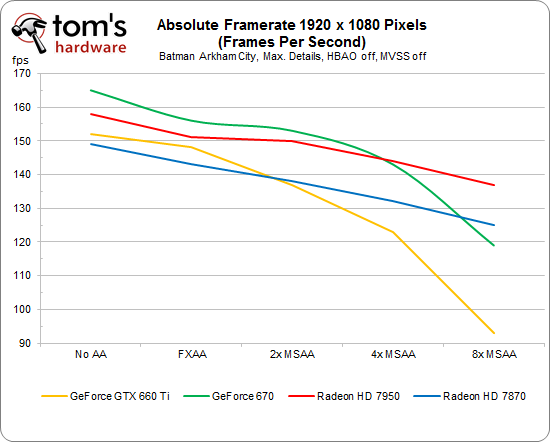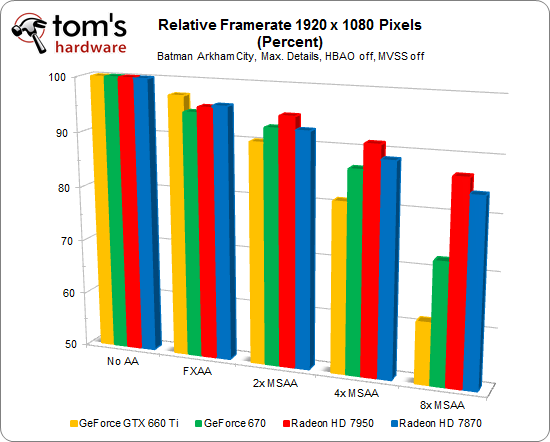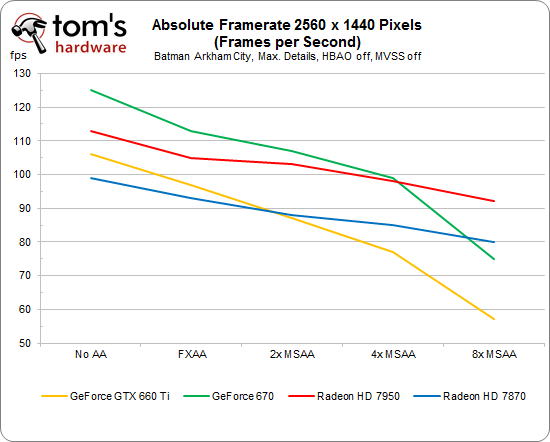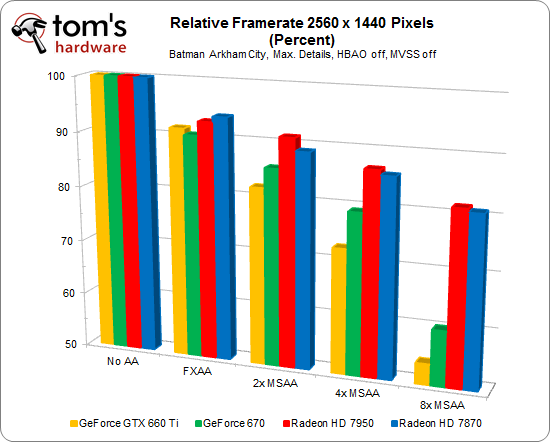Seven GeForce GTX 660 Ti Cards: Exploring Memory Bandwidth
Seven GeForce GTX 660 Tis landed in our lab. Today, we're benchmarking them, measuring their noise and temperatures, and conducting a more in-depth analysis of the impact a 192-bit memory interface has on performance. The results are enlightening!
Testing For Memory Interface Limitations: All Cards Compared
First, we plotted the frames per second achieved by each card. Then, we used the benchmark results with no anti-aliasing as our 100% reference point and calculated the percentage of this for the other settings. This illustrates how much of their original performance the cards lose when anti-aliasing is applied and no CPU or GPU limitation is in play.
Performance at 1920x1080
Performance at 2560x1440
First things first: these numbers are less sensational than they look. Other benchmarks we've run using different games show that many titles are better able to mask the GeForce GTX 660 Ti's narrower memory bus. Sometimes, a lack of bandwidth is less noticeable, if it is at all. So, it could be a problem or not, depending on the situation.
We did show, however, that the card is very much held back by its 192-bit aggregate interface, even if you're using simple anti-aliasing and normal texture detail. The negative effects of this aren't apparent if you're pushing GPU-intensive settings like tessellation able to shift the burden onto the GPU. Giving the GeForce GTX 660 Ti another gigabyte of memory, totaling 3 GB, is pointless, though. Even games that are modified to support huge textures demonstrate worse performance with 3 GB compared to 2 GB. Higher clock rates help make up for the bandwidth deficiency somewhat, but they don't cure the card's underlying problem. A GeForce GTX 660 Ti with 1.5 GB for a bit less money would probably be a good idea.
So, where does all of this leave Nvidia's GeForce GTX 660 Ti with its 192-bit memory interface? Definitely behind AMD's Radeon HD 7950, which is just a better-balanced offering all around. Depending on how much the game you're running stresses the GPU, and if anti-aliasing is enabled, even the less expensive Radeon HD 7870 could be a better choice. This is mostly the case for poorly-optimized console ports lacking DirectX 11 support.
The biggest problem for the GeForce GTX 660 Ti at this point is its price. If you simply prefer Nvidia's cards and are looking to spend around $300, this card is your only choice (though some partner board are being priced even higher). Should they become more affordable, we'd be more comfortable suggesting the GeForce GTX 660 Ti to anyone looking to game at 1920x1080 with up to 4x MSAA.
Get Tom's Hardware's best news and in-depth reviews, straight to your inbox.
Three things surprised us when we started looking at our benchmark numbers. First, AMD's Radeon cards scaled very well with anti-aliasing, especially the Radeon HD 7870. Second, Nvidia’s GeForce cards were able to hold their own well, even at higher resolutions, so long as anti-aliasing was kept under 4x MSAA. Finally, we really didn’t expect to see the GeForce GTX 660 Ti get outperformed by two passively-cooled Radeon HD 7750s.
So what does this tell us?
We aren't saying that anyone else ran their benchmarks on Nvidia's GeForce GTX 660 Ti incorrectly. Really, the card that wins depends on games, settings, and resolutions. This card isn’t a good choice for less demanding titles, but it does make a strong showing when a lot of GPU performance and, relatively speaking, not a lot of memory bandwidth are needed. But this exposes the card's big issue. Nvidia's GeForce GTX 660 Ti isn’t really a premium card. It would need to perform better at higher-end settings to satisfy the folks shopping for a less expensive alternative to the GTX 670. If you're really only looking for a middle-of-the-road card to game at mainstream resolutions and modest settings, the less expensive Radeon HD 7870 is ample.
Current page: Testing For Memory Interface Limitations: All Cards Compared
Prev Page Testing For Memory Interface Limitations: 2560x1440 Next Page Power Consumption
Igor Wallossek wrote a wide variety of hardware articles for Tom's Hardware, with a strong focus on technical analysis and in-depth reviews. His contributions have spanned a broad spectrum of PC components, including GPUs, CPUs, workstations, and PC builds. His insightful articles provide readers with detailed knowledge to make informed decisions in the ever-evolving tech landscape
-
scotthulbs I'd Like to know which 2GB model 660ti you used in this comparison? I would like to see how if perhaps the Zotac memory overclock has much of an effect on performance. If you used the Zotac in this comparison that may very well be the reason it outperforms the 3GB Galaxy card? Maybe run this same test overclocking the memory, it seems as though the 660ti with its memory overclocked can nearly reach GTX670 Bandwidth. I'd like to see how much that helps overcome the narrow bus.Reply -
mayankleoboy1 The problem with wider memory interface is that it exponentially increases the chip's die-size. Hence, cost per wafer and power consumption will increase a lot.Reply
IMO both AMD and Nvidia should use the XDR2 memory in the next series of cards. That would give the same bandwidth at half the interface size. -
iknowhowtofixitThis review reinforces what I have been saying for weeks. The GTX 660Ti is overpriced at $300. Since you can easily find a HD7950 for $300 or less after rebates, it makes the 660TI irrelevant. To me, the 660Ti needs to be $60-$75 cheaper before it can achieve bang for the buck status.it is because of the 660ti that the 7950 prices dropped to $300 or less with MIR: so tell me how irrelevant they are now?Reply
-
ahrensy For the Batman Arkham City tests on the 670 and 660ti, was the PhysX setting set to Off, Low or High?Reply -
EzioAs Reply9537131 said:it is because of the 660ti that the 7950 prices dropped to $300 or less with MIR: so tell me how irrelevant they are now?
The 7950 has been our for months now compared to the 660ti and the price drop happens before the release of the 660ti. Nvidia should really have predicted that the 7950 prices should come down even more so it makes almost no sense that they release the 660ti at $300.
The 7870 performs just slightly slower compared to the 660ti but beats it once you crank up the AA really high and it costs $50 less. On the other hand the 7950 is overall faster than the 660ti and even surpass the the $60+ 670 once you crank the AA really high as well. For the 660ti to sell, Nvidia should really lower it to $260 imo.....or they could just rely on fanboys -
Reply9537133 said:The 7950 has been our for months now compared to the 660ti and the price drop happens before the release of the 660ti.
AMD cuts HD 7000 series price even furtherTuesday, 21 August 2012 08:57 (after the 660ti release)
AMD has already dropped the HD 7970 from US $479 to US $429, HD 7950 from US $399 to US $349 and the HD 7870 down from US $349 to US $299. The new price cut skips the HD 7970 graphics card but includes the HD 7950, HD 7870 as well as the 1 and 2GB versions of the HD 7850.
The most important is probably the price cut for the 3GB HD 7950 which battles it out with Nvidia's recently released GTX 660 Ti. The HD 7950 3GB is, according to the report, will receive a US $30 price cut placing it at US $320. The HD 7870 2GB graphics card got another US $50 price cut pushing it down to US $250 which probably makes it one of the most interesting mid-range graphics cards on the market.
cheers! :) -
FormatC Reply
PhysX was off, because it affects the overall performance. PhysX is dead - ok, not quite, but almost ;)9537132 said:For the Batman Arkham City tests on the 670 and 660ti, was the PhysX setting set to Off, Low or High?
-
EzioAs Reply9537134 said:AMD cuts HD 7000 series price even furtherTuesday, 21 August 2012 08:57 (after the 660ti release)
AMD has already dropped the HD 7970 from US $479 to US $429, HD 7950 from US $399 to US $349 and the HD 7870 down from US $349 to US $299. The new price cut skips the HD 7970 graphics card but includes the HD 7950, HD 7870 as well as the 1 and 2GB versions of the HD 7850.
The most important is probably the price cut for the 3GB HD 7950 which battles it out with Nvidia's recently released GTX 660 Ti. The HD 7950 3GB is, according to the report, will receive a US $30 price cut placing it at US $320. The HD 7870 2GB graphics card got another US $50 price cut pushing it down to US $250 which probably makes it one of the most interesting mid-range graphics cards on the market.
cheers! :)
If you check the price of the 7950s before this news at most online retailer (Newegg, NCIX), you'll know that the price drop happens already although the official news from AMD was a couple of weeks later -
Reply
now you are talking complete nonsense unless you do not understand there were two price drops and the latter of which is because of the 660ti; as the article stated.so you want to see pricing history . . :)9537136 said:If you check the price of the 7950s before this news at most online retailer (Newegg, NCIX), you'll know that the price drop happens already although the official news from AMD was a couple of weeks later
Sapphire Radeon HD 7950 3GB Video Card
now how much sense does it make to drop prices and not tell anyone?
:pfff:



